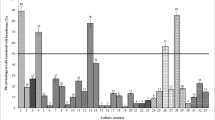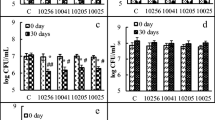Abstract
A novel preparation for human use was investigated for probiotic properties of new lactobacilli isolates from oral and fecal samples of children. Identified strains were Lactobacillus plantarum (Lac1, Lac2, Lac6, and Lac7), Lactobacillus casei (Lac3), and Lactobacillus paracasei (Lac4). Isolates were non-hemolytic, produced organic acids, were tolerant to wide ranges of temperature, NaCl, and pH, and were highly resistant to lysozyme, acidity, and bile salts. High survival rates in artificial gastric and intestinal fluids indicated abilities to survive passage through the gastrointestinal tract. Antimicrobial activities were restricted to bacteria, attributed to low pH values. Isolated strains possessed good aggregation abilities, high hydrophobicity values, and moderate abilities to adhere to HCT 116 cells. Substantial probiotic features were identified for all isolates. Lac2, Lac6, and Lac7 were identified as the most advantageous candidates for further study of other probiotic and technological properties.
Similar content being viewed by others
References
Botina SG, Koroban NV, Klimina KM, Glazova AA, Zakharevich NV, Zinchenko VV, Danilenko VN. Genetic diversity of the genus Lactobacillus bacteria from the human gastrointestinal microbiome. Russ. J. Genet. 46: 1399–1406 (2010)
Goel AK, Dilbaghi N, Kamboj DV, Singh L. Probiotics: Microbial therapy for health modulation. Defence Sci. J. 56: 513–529 (2006)
Guo Z, Wang J, Yan L, Chen W, Liu X, Zhang H. In vitro comparison of probiotic properties of Lactobacillus casei Zhang, a potential new probiotic, with selected probiotic strains. LWT-Food Sci. Technol. 42: 1640–1646 (2009)
FAO/WHO. Health and nutritional properties and guidelines for evaluation. In: FAO/WHO Expert Consultation on Probiotics in Food. Ontario, Canada (2002)
Lim SM. Antimutagenicity activity of the putative probiotic strain Lactobacillus paracasei subsp. tolerans JG22 isolated from pepper leaves jangajji. Food Sci. Biotechnol. 23: 141–150 (2014)
Sengupta R, Altermann E, Anderson RC, McNabb WC, Moughan PJ, Roy NC. The role of cell surface architecture of lactobacilli in host-microbe interactions in the gastrointestinal tract. Mediat. Inflamm. Article ID 237921 (2013)
Van Tassell ML, Miller MJ. Lactobacillus adhesion to mucus. Nutrients 3: 613–636 (2011)
Bergillos-Meca T, Costabile A, Walton G, Moreno-Montoro M, Ruiz-Bravo A, Ruiz-Lopez MD. In vitro evaluation of the fermentation properties and potential probiotic activity of Lactobacillus plantarum C4 in batch culture systems. LWT-Food Sci. Technol. 60: 420–426 (2015)
Gülden BK, Kuleasan H, Sömer VF, Akpinar D. Determining potential probiotic properties of human originated Lactobacillus plantarum strains. Biotechnol. Bioproc. E. 18: 479–485 (2013)
Marques TM, Wall R, Ross RP, Fitzgerald GF, Ryan CA, Stanton C. Programming infant gut microbiota: Influence of dietary and environmental factors. Curr. Opin. Biotech. 21: 149–156 (2010)
Hammes WP, Hertel C. Bergey's Manual of Systematic Bacteriology. Springer-Verlag, New York, NY, USA. pp. 465–511 (2009)
Gürtler V, Stanisich VA. New approaches to typing and identification of bacteria using the 16S-23S rDNA spacer region. Microbiology 65: 5409–5420 (1996)
Gonzales JM, Mayer F, Moran MA, Hodson RE, Whitman WB. Sagittula stellata gen. nov., sp. nov., a lignin-transforming bacterium from a coastal environment. Int. J. Syst. Evol. Microbiol. 47: 773–780 (1997)
Maragkoudakis PA, Konstantinos CM, Psyrras D, Cremonese S, Fischer J, Cantor MD, Tsakalidou E. Functional properties of novel protective lactic acid bacteria and application in raw chicken meat against Listeria monocytogenes and Salmonella enteriditis. Int. J. Food Microbiol. 130: 219–226 (2009)
Collado MC, Meriluoto J, Salminen S. Adhesion and aggregation properties of probiotic and pathogen strains. Eur. Food Res. Technol. 226: 1065–1073 (2008)
Deepika G, Green RJ, Frazier RA, Charalampopoulos D. Effect of growth time on the surface and adhesion properties of Lactobacillus rhamnosus GG. J. Appl. Microbiol. 107: 1230–1240 (2009)
Sanchez B, Fernandez-Garcia M, Margolles A, de los Reyes-Gavilan CG, Ruas-Madiedo P. Technological and probiotic selection criteria of a bile-adapted Bifidobacterium animalis subsp. lactis strain. Int. Dairy J. 20: 800–805 (2010)
Mishra V, Prasad DN. Application of in vitro methods for selection of Lactobacillus casei strains as potential probiotics. Int. J. Food Microbiol. 103: 109–115 (2005)
Zarate G, Perez Chaia A, Gonzalez S, Oliver G. Viability and β-galactosidase activity of dairy propionic bacteria subjected to digestion by artificial gastric and intestinal fluids. J. Food Protect. 63: 1214–1221 (2000)
Ishibashi N, Yamazaki S. Probiotics and safety. Am. J. Clin. Nutr. 173: 465S–470S (2001)
Pereira DI, Gibson GR. Cholesterol assimilation by lactic acid bacteria and bifidobacteria isolated from the human gut. Appl. Environ. Microb. 68: 4689–4693 (2002)
Todorov SD. Bacteriocins from Lactobacillus plantarum-production, genetic organization and mode of action. A review. Braz. J. Microbiol. 40: 209–221 (2009)
Williams NT. Probiotics. Am. J. Health-Syst. Ph. 67: 449–458 (2010)
Belicová A, Mikulášová M, Dušinský R. Probiotic potential and safety properties of Lactobacillus plantarum from Slovak bryndza cheese. Bio. Med. Res. Int. Article ID 760298 (2013)
García-Cayuela T, Korany AM, Bustos I, de Cadiñanos LPG, Requena T, Peláez C, Martínez-Cuesta MC. Adhesion abilities of dairy Lactobacillus plantarum strains showing an aggregation phenotype. Food Res. Int. 57: 44–50 (2014)
Kõll P, Mändar R, Marcotte H, Leibur E, Mikelsaar LM, Hammarström L. Characterization of oral lactobacilli as potential probiotics for oral health. Oral Microbiol. Immun. 23: 139–147 (2008)
Depamede SN, Asri N, Julisaniah NI, Suryadi BF, Kisworo D. Isolation and partial purification of lysozyme from saliva of Bali cattle (Bos sondaicus) using an aqueous mixture of polyethylene glycol (PEG) with sodium sulfate. Afr. J. Biotechnol. 11: 1977–1980 (2012)
Liong MT, Shah NP. Acid and bile tolerance and cholesterol removal ability of lactobacilli strains. J. Dairy Sci. 88: 55–66 (2005)
Fernandez MF, Boris S, Barbes C. Probiotic properties of human lactobacilli strains to be used in the gastrointestinal tract. J. Appl. Microbiol. 94: 449–455 (2003)
Tinrat S, Saraya S, Chomnawang MT. Isolation and characterization of Lactobacillus salivarius MTC 1026 as a potential probiotic. J. Gen. Appl. Microbiol. 57: 365–378 (2011)
Petrovic T, Dimitrijevic S, Radulovic Z, Mirkovic N, Rajic J, Obradovic D, Nedovic V. Comparative analysis of the potential probiotic abilities of lactobacilli of human origin and from fermented vegetables. Arch. Biol. Sci. 64: 1473–1480 (2012)
Turková K, Mavriè A, Narat M, Rittich B, Španová A, Rogelj I, Bogoviè Matijašic B. Evaluation of Lactobacillus strains for selected probiotic properties. Folia Microbiol. 58: 261–267 (2013)
Pisano MB, Casula M, Corda A, Fadda ME, Deplanoand M, Cosentino S. In vitro probiotic characteristics of Lactobacillus strains isolated from fioresardo cheese. Ital. J. Food Sci. 20: 505–516 (2008)
Zavišić G, Radulović Ž, Vranić V, Begović J, Topisirović Lj, Strahinić I. Characterization and activity of vaginal Lactobacillus isolate. Arch. Biol. Sci. 63: 29–35 (2011)
Zavišić G, Petrièević S, Radulović Ž, Begović J, Golić N, Topisirović Lj, Strahinić I. Probiotic features of two oral Lactobacillus isolates. Braz. J. Microbiol. 43: 418–428 (2012)
Author information
Authors and Affiliations
Corresponding author
Rights and permissions
About this article
Cite this article
Jovanović, J.N., Nikolić, B., Šeatović, S. et al. Characterization of some potentially probiotic Lactobacillus strains of human origin. Food Sci Biotechnol 24, 1781–1788 (2015). https://doi.org/10.1007/s10068-015-0232-7
Received:
Revised:
Accepted:
Published:
Issue Date:
DOI: https://doi.org/10.1007/s10068-015-0232-7




